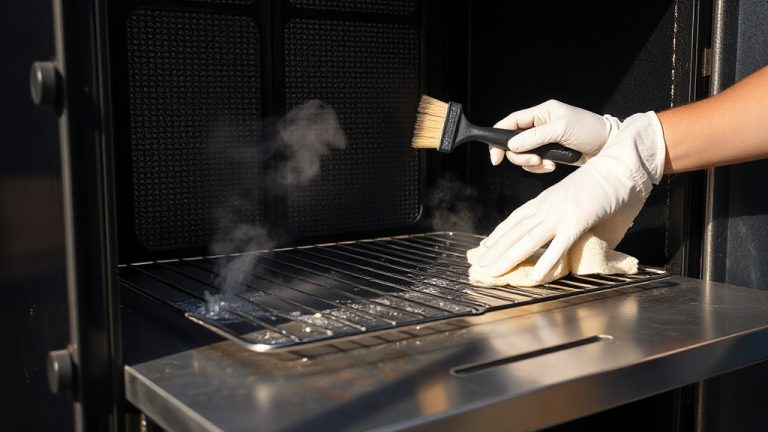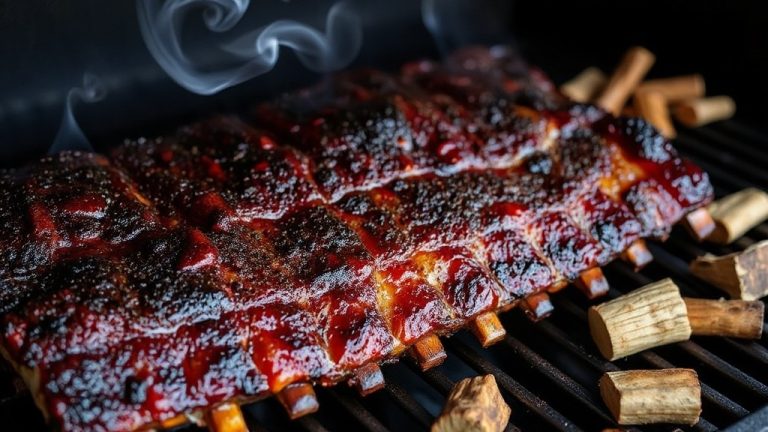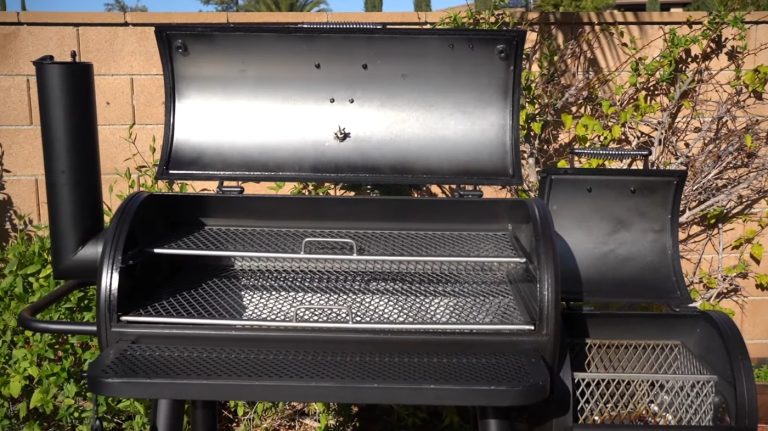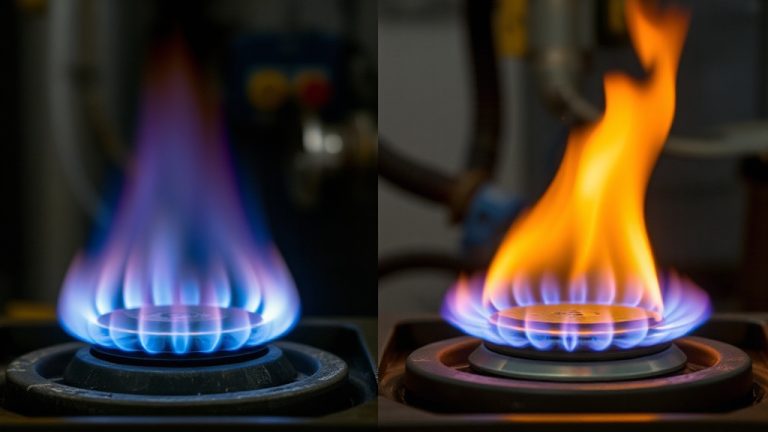How Long Can I Rest a Brisket in a Cooler? Full Guide
You can rest a brisket in a cooler for up to four hours without sacrificing moisture or tenderness if you wrap it tightly in foil or butcher paper and insulate it with towels or blankets.
Keep the cooler preheated and avoid opening it frequently to maintain temperatures above 140°F, ensuring food safety.
Regularly check the internal temperature and reheat if needed. Properly done, this extended resting boosts flavor and juiciness—learn how to optimize every step for the best results.
Key Takeaways
- Brisket can safely rest in a preheated, insulated cooler for 2 to 4 hours to maximize moisture and tenderness.
- Maintain internal temperature above 140°F during resting to prevent bacterial growth and ensure food safety.
- Wrap brisket tightly in foil or butcher paper and insulate with towels to retain heat and moisture effectively.
- Avoid frequent cooler opening to preserve consistent temperature and prevent heat loss during the resting period.
- Monitor internal temperature every 30-60 minutes and reheat brisket to 165°F if it drops below safe levels.
Optimal Resting Duration for Brisket in a Cooler
Although you might be eager to slice into your brisket right away, allowing it to rest in a cooler for 2 to 4 hours is essential for ideal moisture retention and tenderness. This timeframe lets the juices redistribute evenly throughout the meat, enhancing both texture and flavor.
Rest your brisket 2 to 4 hours in a cooler for optimal juiciness and tenderness.
Wrap your brisket tightly in butcher paper or aluminum foil to lock in moisture, then insulate it with towels inside a large cooler.
Avoid placing ice inside, as rapid temperature drops can compromise the resting process. Using a high-quality cooler and preheating it with hot water can significantly extend safe holding time by maintaining the internal temperature management. Proper insulation also helps moderate the effects of humidity that can influence meat texture during resting.
While resting beyond 4 hours is possible and can soften the brisket further, it often yields diminishing returns.
Maintaining Safe Temperatures During Rest
When resting your brisket in a cooler, maintaining a safe internal temperature above 140°F is crucial to prevent bacterial growth and guarantee food safety. Using a cooler with proper insulation helps retain heat longer and ensures temperature stability.
To do this, use a high-quality, well-insulated cooler preheated with hot towels or water. Wrap your brisket tightly in foil or butcher paper and place it inside with layers of towels above and below to trap heat effectively.
Many pitmasters have adopted the practice of wrapping brisket in foil with beef broth before resting to improve moisture, texture, and tenderness, enhancing overall quality. This method, known as traditional foil wrapping, has been used since 1997.
Monitor the internal temperature at the thickest part with a digital probe thermometer, checking every 30 to 60 minutes. Avoid opening the cooler frequently to maintain consistent heat. If the temperature dips below 140°F, remove the brisket to prevent entering the Danger Zone.
Benefits of Extended Resting Periods
When you let your brisket rest extended periods in a cooler, you lock in moisture by allowing natural juices to redistribute evenly throughout the meat. Below are some key benefits of extended resting periods:
Enhanced Tenderness
Because extended resting periods allow muscle fibers to fully relax after cooking, you’ll notice a significant improvement in brisket tenderness. This relaxation reduces internal tension, letting you slice through the meat with less resistance and minimal breakage.
Wrapping the brisket loosely in foil and insulating it in a cooler helps retain moisture and promotes even heat distribution during the resting phase, similar to how a roasting bag works for turkey.
When you rest brisket properly—wrapped and insulated in a cooler—the slow temperature decline supports enzymatic activity that breaks down tough connective tissues into softer gelatins.
This gradual process prevents protein tightening and moisture loss, enhancing the meat’s structure for a consistently tender bite throughout. Resting also allows the collagen dissolved during cooking to firm up again, thickening the juices and enhancing flavor retention collagen dissolution.
For large briskets, resting 45 minutes to over an hour is ideal, ensuring peak tenderness before slicing. Using a faux Cambro setup or a quality cooler with towels slows the temperature drop, maximizing these benefits.
Moisture Redistribution
Although brisket loses some moisture during cooking, allowing it to rest for an extended period lets the muscle fibers relax and reabsorb those precious juices. This moisture redistribution prevents a dry, stringy center and ensures each slice stays juicy.
Resting in a properly insulated cooler keeps the brisket above 140°F, maintaining safety while maximizing juiciness.
You’ll notice a more uniform texture and minimal juice loss after slicing. For longer holding periods, it is advisable to cool the brisket down to about 150°F before placing it in a cooler to prevent overcooking and moisture loss temperature management.
- Muscle fibers contract during cooking, pushing moisture outward
- Extended rest lets fibers relax and reabsorb juices
- Cooler resting retains heat, preventing moisture evaporation
- Longer rests (2–4 hours or overnight) enhance juiciness and texture
Flavor Development
As you let your brisket rest in a cooler, the extended period unseals remarkable flavor development by allowing juices rich with seasoning and smoke to redistribute evenly throughout the meat.
During this time, muscle fibers relax, enabling these flavorful juices to permeate every bite. Wrapping the brisket tightly in plastic wrap before placing it in the cooler helps maintain moisture and prevents evaporation during the rest.
The warm environment encourages continued fat rendering, enhancing savory, umami notes. Smoke compounds further penetrate, deepening complexity while heat equalizes, ensuring consistent flavor from edge to center. Managing temperature control during this resting phase is crucial to avoid overcooking or flavor loss.
Enzymatic activity tenderizes the meat and helps salt migrate uniformly, intensifying seasoning. Resting also preserves the bark’s crispness, maintaining caramelized flavors and texture.
You’ll find that a rest of 2 to 4 hours offers peak flavor integration, with longer rests further melding flavors—ideal for achieving a balanced, deeply satisfying brisket.
Wrapping Techniques for Cooler Resting
You’ll want to wrap your brisket tightly in foil to lock in heat and moisture during cooler resting. This method helps prevent drying out while preserving the meat’s tenderness and flavor.
Many pitmasters prefer butcher paper for its breathability, which helps maintain a bark without trapping too much steam. Using breathable materials is essential to avoid sogginess and maintain texture during the resting phase.
Combining these materials strategically can optimize temperature retention and texture. This technique is similar to how smoking garlic involves wrapping to lock in aroma and moisture for optimal softness.
Using a preheated cooler and insulating the brisket with towels can help maintain the internal temperature above 135°F, ensuring food safety during the rest.
Foil Wrapping Benefits
Why should you wrap your brisket tightly in foil before resting it in a cooler? Foil sealing locks in moisture, prevents air exposure, and maintains heat, all vital for preserving brisket quality during extended rests.
It also protects against contamination and collects flavorful juices for serving. Wrapping the meat helps maintain an even internal temperature, preventing uneven cooling that can affect texture.
Key benefits include:
- Retains moisture and prevents juice loss, keeping meat tender and flavorful.
- Reflects heat to slow temperature drop and ensure even warming.
- Acts as a hygienic barrier inside communal coolers.
- Simplifies transport and cleanup by containing drips and fitting various cooler sizes.
- Additionally, wrapping in foil helps promote redistribution of juices within the meat, enhancing tenderness and succulence during the resting period.
Butcher Paper Usage
While foil excels at locking in moisture and heat, butcher paper offers a different approach that many pitmasters prefer for resting brisket in a cooler.
Butcher paper allows your brisket to breathe, preventing over-steaming and preserving the bark’s texture. To wrap properly, use two overlapping 18-inch sheets, spritzed with water for pliability.
Wrap fat side up, folding short edges first, then tucking long edges tightly to minimize air pockets. This technique balances flavor preservation while still allowing some smoke contact.
Pull the paper snugly to contour the brisket before finalizing the seam. Once wrapped, place the brisket in a preheated cooler, adding towels to boost insulation since butcher paper retains less heat than foil.
Using a cooler for resting helps maintain a consistent temperature, which is crucial for preserving moisture and tenderness.
Insulation Methods to Retain Heat
Because maintaining heat is essential for a perfectly rested brisket, using effective insulation methods inside your cooler is crucial. Start by pre-warming your cooler with hot water to create a warm environment.
Wrap the brisket tightly in foil, then cover it with towels or insulated blankets to trap thermal energy. This method allows the brisket to rest in a thermal-insulated cooler, preserving moisture and tenderness over an extended period.
Choose a high-quality cooler with excellent insulation to extend heat retention.
Position the cooler in a shaded, stable area to minimize heat loss.
- Preheat the cooler to maintain ambient warmth
- Wrap brisket in foil and towels for thermal barriers
- Use a high-quality cooler for superior insulation
- Place cooler in a shaded spot to reduce external temperature impact
Food Safety Considerations While Resting
Maintaining heat during the resting phase is only part of the challenge; ensuring your brisket stays safe to eat requires careful temperature management. You must keep the internal temperature at or above 140°F to prevent bacterial growth.
Use a thermometer to monitor temps periodically, and wrap the brisket tightly to retain heat and moisture. If the temperature drops below 140°F, reheat to at least 165°F or refrigerate promptly.
Many pitmasters use insulated coolers with towels or heated blocks as a thermal mass to maintain safe temperatures for several hours without overcooking.
| Condition | Temperature Range | Action Required |
|---|---|---|
| Safe holding temp | ≥ 140°F | Continue resting safely |
| Danger zone | 40°F – 140°F | Reheat or refrigerate brisket |
| Refrigeration needed | < 40°F | Store properly, no resting |
Consistent monitoring and proper insulation are critical to avoid foodborne risks during resting.
Comparing Cooler Resting to Other Methods
When you choose to rest a brisket in a cooler, you benefit from a practical and accessible method that balances temperature control and convenience.
Unlike specialized equipment, coolers are more affordable and widely available, making them ideal for home cooks. Resting in a cooler allows the brisket to undergo moisture redistribution, enhancing tenderness and juiciness.
While Cambro units offer superior temperature uniformity, their cost and size can be prohibitive. Steam cabinets excel in maintaining warmth over long periods but suit commercial settings better.
Coolers provide stable, slow cooling without the risk of overcooking, preserving juiciness effectively.
- Coolers offer cost-effective, home-friendly resting.
- Cambro units provide more consistent temperature control.
- Steam cabinets maintain extended warmth, ideal for restaurants.
- Coolers reduce overcooking risk with cooler resting environments.
Practical Tips for Resting Brisket at Home
Choosing a cooler for resting your brisket offers a smart balance of temperature control and convenience, but to get the best results at home, you need to prepare properly. Start by preheating the cooler and wrapping the brisket tightly in foil or butcher paper to retain moisture.
Add towels for insulation and keep the cooler out of direct sunlight. Monitoring the internal temperature regularly is essential because resting at temperatures below 140°F risks food safety.
Monitor the temperature regularly, aiming to stay above 140°F, and adjust rest time depending on the brisket’s size and when you plan to serve.
| Tip | Reason |
|---|---|
| Use a large cooler | Accommodates brisket comfortably |
| Preheat cooler | Maintains ideal temperature |
| Wrap brisket tightly | Retains moisture and flavor |
| Insulate with towels | Enhances heat retention |
| Monitor temp often | Ensures food safety |
Frequently Asked Questions
Can I Rest Brisket in a Cooler Overnight Safely?
You can rest brisket in a cooler overnight only if you keep it above 135°F the entire time to prevent bacterial growth. This requires a high-quality, well-insulated cooler, preheating it properly, and wrapping the brisket tightly.
Without strict temperature control, overnight resting in a standard cooler isn’t safe. Always use a probe thermometer to monitor internal temperature. For safer overnight holding, commercial warming equipment is the best option.
Should I Slice Brisket Before or After Resting in a Cooler?
You might worry slicing early saves time, but slicing brisket before resting causes juicy moisture to leak out, leaving it dry. Instead, keep it whole while resting in a cooler. This helps the juices redistribute evenly, making your brisket tender and moist.
Wrap it tightly in foil and insulate well to maintain temperature. Slice only after resting to enjoy the best texture and flavor, ensuring every bite is succulent and satisfying.
How Does Resting Brisket in a Cooler Affect Smoke Flavor?
Resting brisket in a cooler enhances smoke flavor by locking in aromatic compounds and preventing moisture loss.
When you wrap it tightly and insulate properly, the cooler maintains a stable temperature, allowing smoke-infused juices to redistribute evenly.
This slow cooling process deepens the smoke penetration, making the flavor more pronounced and balanced.
Can I Rest Other Meats in a Cooler Like Brisket?
They say, “Good things come to those who wait,” and that applies here. Yes, you can rest other meats in a cooler like brisket.
Just wrap them well and keep the temperature above 135°F to stay safe. Smaller or thinner cuts don’t hold heat well, so cooler resting isn’t ideal.
What Cooler Size Is Best for Resting a Whole Brisket?
You want a cooler that fits your whole brisket comfortably, with enough extra space for towels or blankets to insulate.
For a 12-14 lb brisket, a 48-quart cooler usually works well. If your brisket is larger, say 15 lbs or more, go for a 60-quart or bigger.
Avoid oversized coolers for small briskets since excess airspace cools the meat faster and reduces insulation efficiency.
Keep the Brisket Resting Right for Bold Flavor
When you let your brisket take its well-deserved break in a cooler, you’re giving it the chance to settle into perfection. Aim for a rest of up to 4 hours, keeping temperatures cozy but safe to let those flavors mingle beautifully.
Wrap it snugly and insulate wisely to preserve warmth without rushing the process. By mastering this gentle pause, you’ll turn a good brisket into an unforgettable experience that’s worth every moment of patience.






